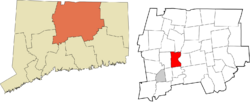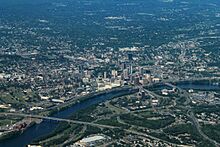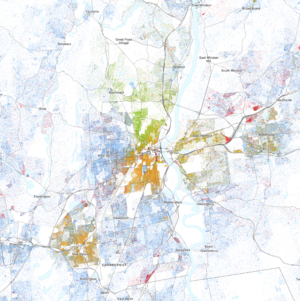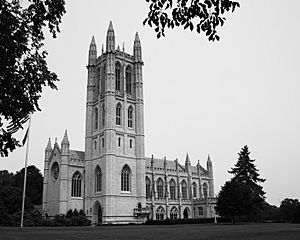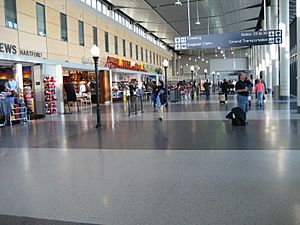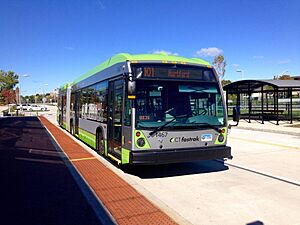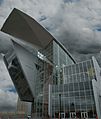Hartford, Connecticut facts for kids
Quick facts for kids
Hartford
|
|||
|---|---|---|---|
|
Downtown seen from the Connecticut River
UConn Law
|
|||
|
|||
Nickname(s):
|
|||
| Motto(s):
Post Nubila Phoebus (Latin)
"After the clouds, the sun" |
|||
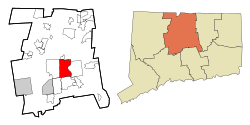 Hartford County and Connecticut Hartford County and Connecticut |
|||
| Country | United States | ||
| State | Connecticut | ||
| County | Hartford | ||
| Region | Capitol Region | ||
| MSA | Greater Hartford | ||
| Settled | October 15, 1635 | ||
| Named | February 21, 1637 | ||
| Incorporated (city) | May 29, 1784 | ||
| Consolidated | April 1, 1896 | ||
| Named for | Hertford, Hertfordshire | ||
| Government | |||
| • Type | Mayor-council | ||
| Area | |||
| • State capital | 18.05 sq mi (46.76 km2) | ||
| • Land | 17.38 sq mi (45.01 km2) | ||
| • Water | 0.68 sq mi (1.75 km2) | ||
| • Urban | 535.93 sq mi (1,388.0 km2) | ||
| Elevation | 30 ft (9 m) | ||
| Population
(2020)
|
|||
| • State capital | 121,054 | ||
| • Density | 6,965.1/sq mi (2,689.5/km2) | ||
| • Urban | 977,158 (US: 47th) | ||
| • Urban density | 1,823.3/sq mi (704.0/km2) | ||
| • Metro | 1,214,295 (US: 48th) | ||
| • CSA | 1,489,361 (US: 41st) | ||
| Demonym(s) | Hartfordite | ||
| GDP | |||
| • Hartford (MSA) | $114.887 billion (2022) | ||
| Time zone | UTC−05:00 (EST) | ||
| • Summer (DST) | UTC−04:00 (EDT) | ||
| ZIP Codes |
061xx
|
||
| Area code(s) | 860/959 | ||
| FIPS code | 09-37000 | ||
| GNIS feature ID | 2378277 | ||
| Primary airport | Bradley International Airport | ||
| Secondary airport | Hartford–Brainard Airport | ||
| Interstates | |||
| U.S. Highways | |||
| State routes | |||
| Commuter rail | |||
| Rapid transit | |||
Hartford is the capital city of Connecticut, a state in the United States. It's located in Hartford County. In 2020, about 121,054 people lived there. Hartford is the biggest city in its region, called the Capitol Planning Region. It's also the main city of the larger Greater Hartford area.
Hartford was founded in 1635, making it one of the oldest cities in the U.S. It's home to many "firsts" and "oldests" in the country. For example, it has the oldest public art museum (Wadsworth Atheneum), the oldest publicly funded park (Bushnell Park), and the oldest newspaper that's still printed (Hartford Courant). It also has the second-oldest high school (Hartford Public High School) and the oldest school for deaf children (American School for the Deaf).
The famous author Mark Twain lived in Hartford and wrote many of his best-known books there. He once said Hartford was the "chief" of all the beautiful towns he had seen. Since 1875, Hartford has been the only capital of Connecticut. Before that, it shared the role with New Haven.
Hartford is often called the "Insurance Capital of the World." Many big insurance companies have their main offices here. Other important jobs in the city are in healthcare, education, and other services. While some families in Hartford face financial challenges, the larger Hartford area has a strong economy.
Contents
- Hartford's History: A Journey Through Time
- Hartford's Geography and Climate
- People and Population in Hartford
- Hartford's Economy: Industries and Jobs
- Arts, Culture, and Fun in Hartford
- Sports Teams in Hartford
- Education in Hartford
- Media and Communication in Hartford
- Getting Around Hartford: Transportation
- Notable People from Hartford
- Recent Developments in Hartford
- Sister Cities
- Images for kids
- See also
Hartford's History: A Journey Through Time
Long ago, different Native American tribes lived in the Hartford area. These included the Podunks, Poquonocks, Massacoes, Tunxis, Wangunks, and Saukiog peoples. They were all part of the Algonquian peoples group.
Early European Explorers and Settlers
The first Europeans to explore this area were the Dutch in 1614. They sailed up the Connecticut River. In 1623, Dutch fur traders from New Amsterdam (which is now New York City) came back. They wanted to set up a trading post and a fort for the Dutch West India Company.
This fort was called Fort Hoop or the "House of Hope." It was located near the Park River. The Dutch bought the land from the Pequot chief in 1633. Only a few families and soldiers lived at the fort. The Dutch left the fort by 1654. Today, this area is known as Dutch Point.
English settlers started arriving in 1636. They settled north of the Dutch fort. Puritan pastors Thomas Hooker and Samuel Stone led about 100 settlers and 130 cattle from Newtown, Massachusetts (now Cambridge). They started their new town.
The settlement was first called Newtown. But in 1637, its name was changed to Hartford. This was to honor Stone's hometown of Hertford, England. The name Hartford means a "deer crossing" or a "ford where harts (deer) cross."
Thomas Hooker was an important minister in Hartford. In 1638, his ideas helped create the Fundamental Orders of Connecticut. These orders were like a first constitution for Connecticut. They helped the colony become separate from Massachusetts.
The original settlement also had the famous Charter Oak tree. This old white oak tree was where colonists hid Connecticut's Royal Charter in 1662. They wanted to protect it from an English governor. The oak tree is now a symbol on the Connecticut state quarter. You can find the Charter Oak Monument where Charter Oak Place and Charter Oak Avenue meet.
Hartford in the 1800s: A Center of Industry
Around 1850, a Hartford native named Samuel Colt made a big change in manufacturing. He found a way to mass-produce his revolvers with parts that could be swapped out. This meant thousands of guns could be made quickly.
Many other industries started using these methods. Hartford became a major center for making all sorts of products. These included:
- Firearms from Colt, Richard Gatling, and John Browning.
- Sewing machines from Weed.
- Columbia bicycles.
- Pope automobiles.
- Typewriters from Royal Typewriter Company and Underwood Typewriter Company. Hartford was known as the "Typewriter Capital of the World" for a long time.
The Pratt & Whitney Company started in Hartford in 1860. They built a large factory to make machine tools. These tools were used to make sewing machines and guns for the Union Army during the American Civil War. Later, in 1925, the company began designing aircraft engines in Hartford.
In 1852, the Sharps Rifle Manufacturing Company opened a factory near the Park River. This area, called Frog Hollow, changed from farmland to a big industrial area. The Sharps factory was built near a railroad line, which was very helpful for shipping goods.
When the Sharps Rifle Company closed in 1870, the Weed Sewing Machine Company took over its factory. Weed played a big part in making Hartford a top machine tool center. Later, the bicycle and automobile industries also began in the Weed factory.
An industrialist named Albert Pope saw a British bicycle at an exhibition in 1876. He bought the rights to make bicycles in the U.S. He asked the Weed Sewing Machine Company to make his first bicycles in 1878. Bicycles became very popular, and production grew in the Weed factory.
By 1890, bicycles were so popular that Pope bought the Weed factory and renamed it the Pope Manufacturing Company. But the bicycle craze didn't last forever. As more people wanted cars, Pope's company faced financial problems.
Pope tried to save his business by making electric cars. He started with the "Mark III" in 1897. His efforts could have made Hartford the center of the car industry. However, Henry Ford and other challenges prevented this.
In 1876, Hartford Machine Screw started. They invented the first automatic screw machine. This company made thousands of screws every day. They built a new factory next to Weed, where they stayed until 1948.
Hartford in the 1900s: Challenges and Changes

In April 1909, the Connecticut River flooded Hartford, causing a lot of damage. Later, on July 6, 1944, Hartford had one of the worst fire disasters in U.S. history. This was the Hartford Circus Fire, where 168 people, mostly children and their mothers, lost their lives during a circus show.
After World War II, many people from Puerto Rico moved to Hartford. Starting in the late 1950s, the towns around Hartford began to grow. Hartford itself started to face challenges. Big insurance companies like Connecticut General (now CIGNA) moved to new campuses in nearby towns.
Places like Constitution Plaza were built to renew the city. But many department stores, like Brown Thomson and G. Fox & Co., closed as shopping malls in the suburbs became popular.
In 1997, Hartford lost its professional hockey team, the Hartford Whalers. They moved to North Carolina, even though more people were buying tickets and the state offered a new arena. Hartford's population also shrunk in the 1990s. However, the population has grown since 2000.
In 1987, Carrie Saxon Perry became the mayor of Hartford. She was the first African-American woman to be mayor of a major American city. In 1999, Riverfront Plaza opened. This connected the riverfront and downtown for the first time in many years.
Hartford in the 2000s: New Growth and Events
Many cultural events happen each year at Mortensen Plaza, by the Connecticut River. These outdoor events include live music, festivals, dance, and arts and crafts. Hartford also has a lively theater scene. You can see big Broadway shows at the Bushnell Theater. There are also performances at the Hartford Stage and TheaterWorks.
In 2017, Hartford faced financial difficulties. The city had a large budget gap. However, the state stepped in with financial help, preventing the city from having to declare bankruptcy.
Downtown Hartford is usually busy during the day with people working. But it used to be quiet in the evenings and on weekends. Now, more homes and shops are being built, which is starting to change that.
Hartford's Geography and Climate
Hartford covers about 18 square miles (46.76 square kilometers). Most of this is land, with a small part being water.
The city is surrounded by other towns like West Hartford, East Hartford, and Windsor. The Connecticut River forms the border between Hartford and East Hartford. It's on the east side of the city.
The Park River used to divide Hartford. It was a big part of Bushnell Park. But in the 1940s, most of the river was covered up for flood control. You can still see where the river used to be in some roads, like Jewell Street.
Hartford's Weather Patterns
Hartford has a humid continental climate. This means it has hot, humid summers and moderately cold winters with snow. Spring and fall are in-between seasons, with weather that can be warm or cool.
From April to October, Hartford is warm to hot. June, July, and August are the hottest months. In summer, it's often humid, and there are sometimes quick thunderstorms. The cool months are from November to March. December, January, and February are the coldest.
On average, Hartford gets about 47 inches (119 cm) of rain each year. This rain is spread out pretty evenly. It also gets about 51.7 inches (131 cm) of snow in an average winter. This is more snow than cities closer to the coast get.
In summer, temperatures reach or go over 90°F (32°C) about 17 days a year. In winter, overnight temperatures can drop very low, sometimes below 0°F (-18°C). Tropical storms and hurricanes can also affect Hartford, but this is rare. The city saw a lot of damage from the 1938 New England Hurricane.
| Climate data for Bradley International Airport, Connecticut (1981–2010 normals, extremes 1905–present) | |||||||||||||
|---|---|---|---|---|---|---|---|---|---|---|---|---|---|
| Month | Jan | Feb | Mar | Apr | May | Jun | Jul | Aug | Sep | Oct | Nov | Dec | Year |
| Record high °F (°C) | 72 (22) |
73 (23) |
89 (32) |
96 (36) |
99 (37) |
100 (38) |
103 (39) |
102 (39) |
101 (38) |
91 (33) |
83 (28) |
76 (24) |
103 (39) |
| Mean maximum °F (°C) | 55.6 (13.1) |
57.4 (14.1) |
70.1 (21.2) |
82.9 (28.3) |
89.0 (31.7) |
92.8 (33.8) |
95.1 (35.1) |
94.1 (34.5) |
88.7 (31.5) |
79.4 (26.3) |
70.8 (21.6) |
59.0 (15.0) |
97.2 (36.2) |
| Mean daily maximum °F (°C) | 34.5 (1.4) |
38.5 (3.6) |
47.7 (8.7) |
60.5 (15.8) |
71.2 (21.8) |
79.6 (26.4) |
84.5 (29.2) |
82.7 (28.2) |
74.9 (23.8) |
63.1 (17.3) |
51.6 (10.9) |
39.7 (4.3) |
60.7 (15.9) |
| Mean daily minimum °F (°C) | 17.7 (−7.9) |
20.9 (−6.2) |
27.9 (−2.3) |
38.4 (3.6) |
47.7 (8.7) |
57.3 (14.1) |
62.7 (17.1) |
61.1 (16.2) |
52.7 (11.5) |
41.1 (5.1) |
33.2 (0.7) |
23.4 (−4.8) |
40.3 (4.6) |
| Mean minimum °F (°C) | −2 (−19) |
1.9 (−16.7) |
10.7 (−11.8) |
26.2 (−3.2) |
33.5 (0.8) |
44.2 (6.8) |
51.5 (10.8) |
48.4 (9.1) |
37.8 (3.2) |
26.9 (−2.8) |
17.5 (−8.1) |
6.0 (−14.4) |
−4.5 (−20.3) |
| Record low °F (°C) | −26 (−32) |
−24 (−31) |
−6 (−21) |
9 (−13) |
28 (−2) |
37 (3) |
44 (7) |
36 (2) |
30 (−1) |
17 (−8) |
1 (−17) |
−18 (−28) |
−26 (−32) |
| Average precipitation inches (mm) | 3.23 (82) |
2.89 (73) |
3.62 (92) |
3.72 (94) |
4.35 (110) |
4.35 (110) |
4.18 (106) |
3.93 (100) |
3.88 (99) |
4.37 (111) |
3.89 (99) |
3.44 (87) |
45.85 (1,165) |
| Average snowfall inches (cm) | 12.3 (31) |
11.0 (28) |
6.4 (16) |
1.4 (3.6) |
0 (0) |
0 (0) |
0 (0) |
0 (0) |
0 (0) |
0 (0) |
2.0 (5.1) |
7.4 (19) |
40.5 (103) |
| Average precipitation days (≥ 0.01 inch) | 10.8 | 9.7 | 11.5 | 11.2 | 12.8 | 12.2 | 10.4 | 10.0 | 9.8 | 10.2 | 10.7 | 10.7 | 130.0 |
| Average snowy days (≥ 0.1 inch) | 5.8 | 4.7 | 3.5 | 0.5 | 0 | 0 | 0 | 0 | 0 | 0 | 0.9 | 4.7 | 20.1 |
| Average relative humidity (%) | 63.9 | 63.0 | 60.4 | 58.0 | 63.0 | 67.3 | 68.0 | 70.6 | 72.9 | 69.2 | 68.3 | 68.0 | 66.0 |
| Mean monthly sunshine hours | 169.8 | 176.1 | 213.9 | 228.2 | 258.6 | 273.4 | 293.1 | 269.6 | 223.6 | 199.4 | 139.4 | 139.5 | 2,584.6 |
| Percent possible sunshine | 58 | 59 | 58 | 57 | 57 | 60 | 64 | 63 | 60 | 58 | 47 | 49 | 58 |
| Source: NOAA (relative humidity and sun 1961–1990) | |||||||||||||
Exploring Hartford's Neighborhoods
- Downtown is the main business area. It has the State Capitol, Old State House, museums, and shops.
- Parkville is named for where the Park River's branches meet. It's home to Real Art Ways.
- Frog Hollow is close to Downtown. It has Pope Park and Trinity College, one of the oldest colleges in the country.
- Asylum Hill has homes and businesses. Many insurance companies have their main offices here. It's also where Mark Twain and Harriet Beecher Stowe lived.
- The West End has the Governor's residence, Elizabeth Park, and the University of Connecticut School of Law.
- Sheldon Charter Oak is famous for the Charter Oak tree. It also has the former Colt headquarters and Samuel Colt's family home, Armsmear.
- The North East neighborhood has Keney Park and some of the city's oldest and most beautiful homes.
- The South End is known for its "Little Italy" area. It was once home to a large Italian community. Hartford Hospital is also in South Green.
- The South Meadows is where Hartford–Brainard Airport and many industries are located.
- The North Meadows has shops, car dealerships, and the Xfinity Theater.
- Blue Hills (Bloomfield, Connecticut)|Blue Hills is home to the University of Hartford. It also has a large number of residents with Jamaican-American heritage.
- Other neighborhoods include Barry Square, Behind the Rocks, Clay Arsenal, South West, and Upper Albany. Upper Albany has many Caribbean restaurants and shops.
People and Population in Hartford
| Historical population | |||
|---|---|---|---|
| Census | Pop. | %± | |
| 1790 | 2,683 | — | |
| 1800 | 3,523 | 31.3% | |
| 1810 | 3,955 | 12.3% | |
| 1820 | 4,726 | 19.5% | |
| 1830 | 7,074 | 49.7% | |
| 1840 | 9,468 | 33.8% | |
| 1850 | 17,966 | 89.8% | |
| 1860 | 29,152 | 62.3% | |
| 1870 | 37,180 | 27.5% | |
| 1880 | 42,015 | 13.0% | |
| 1890 | 53,230 | 26.7% | |
| 1900 | 79,850 | 50.0% | |
| 1910 | 98,915 | 23.9% | |
| 1920 | 138,036 | 39.6% | |
| 1930 | 164,072 | 18.9% | |
| 1940 | 166,267 | 1.3% | |
| 1950 | 177,397 | 6.7% | |
| 1960 | 162,178 | −8.6% | |
| 1970 | 158,017 | −2.6% | |
| 1980 | 136,392 | −13.7% | |
| 1990 | 139,739 | 2.5% | |
| 2000 | 121,578 | −13.0% | |
| 2010 | 124,775 | 2.6% | |
| 2020 | 121,054 | −3.0% | |
| Population 1800–1990 | |||
Population Snapshot: 2020 Census
| Race / Ethnicity (NH = Non-Hispanic) | Pop 2000 | Pop 2010 | Pop 2020 | % 2000 | % 2010 | % 2020 |
|---|---|---|---|---|---|---|
| White alone (NH) | 21,677 | 19,765 | 15,278 | 17.83% | 15.84% | 12.62% |
| Black or African American alone (NH) | 43,775 | 44,223 | 43,024 | 36.01% | 35.44% | 35.54% |
| Native American or Alaska Native alone (NH) | 328 | 309 | 262 | 0.27% | 0.25% | 0.22% |
| Asian alone (NH) | 1,898 | 3,347 | 4,208 | 1.56% | 2.68% | 3.48% |
| Pacific Islander alone (NH) | 42 | 27 | 34 | 0.03% | 0.02% | 0.03% |
| Some Other Race alone (NH) | 685 | 851 | 1,411 | 0.56% | 0.68% | 1.17% |
| Mixed Race or Multi-Racial (NH) | 3,913 | 2,068 | 3,522 | 3.22% | 1.66% | 2.91% |
| Hispanic or Latino (any race) | 49,260 | 54,185 | 53,315 | 40.52% | 43.43% | 44.04% |
| Total | 121,578 | 124,775 | 121,054 | 100.00% | 100.00% | 100.00% |
In 2020, Hartford had 121,054 people. The city's population is very diverse. Many people are of Hispanic or Latino background, especially from Puerto Rico. This makes Hartford one of the cities with the largest Puerto Rican populations in the Northeast U.S.
There are also smaller groups of people from Mexico, Colombia, Peru, and the Dominican Republic. Among non-Hispanic residents, many people have Jamaican heritage.
The population in Hartford is quite young. About 30% of residents are under 18 years old. The average age in the city is 30 years old.
Hartford's Economy: Industries and Jobs
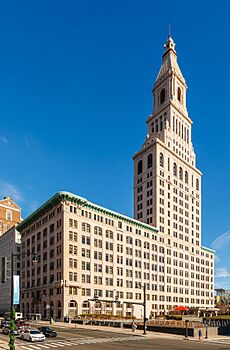
Hartford is a major center for healthcare, research, and education. The city has several hospitals, including Hartford Hospital and Connecticut Children's Medical Center.
Hartford is also famous as a global center for the insurance industry. Many big insurance companies like Aetna, The Hartford, and Travelers have their main offices or large operations here. This is why Hartford is nicknamed the "Insurance Capital of the World."
Other important companies in Hartford include CareCentrix, LAZ Parking, and Virtus Investment Partners. In 2009, Northeast Utilities, a large energy company, moved its main office downtown.
Hartford is also becoming a technology hub. In 2018, Infosys opened a new technology center here, planning to create many jobs. Other tech companies like CGI Inc. and HCL Technologies have also come to Hartford.
Even with these new businesses, finding a job can still be a challenge in Hartford. The unemployment rate is sometimes higher here compared to other cities in Connecticut or the U.S.
Arts, Culture, and Fun in Hartford
Food and Dining in Hartford
Hartford has a rich food history. The first American cookbook, American Cookery, was published here in 1796. It included the first published recipe for pumpkin pie!
The city's food has been shaped by its early Dutch and English settlers, as well as Native American influences. In the 20th century, many Polish and Italian immigrants came, bringing their delicious foods. Today, you can find a wide variety of ethnic foods throughout the city.
Hartford is even called a "foodie destination" by Food and Wine magazine. You can find food trucks in special areas, like near Bushnell Park. The city also hosts several farmers' markets where you can buy fresh, local produce.
Because the seashore is close, seafood is popular. The Connecticut River Valley is also a very productive farming area in New England. Hartford and the surrounding towns also have many craft breweries, cider makers, and distilleries.
Must-See Places in Hartford
- Aetna building – This is the world's largest colonial revival building. It has a tall tower inspired by the Old State House.
- Ancient Burying Ground – Hartford's oldest historic site and first graveyard. Many important founders are buried here.
- Armsmear – The beautiful home of the Colt family.
- Bushnell Center for the Performing Arts – A theater built in the 1930s. It has a Georgian Revival outside and an Art Deco inside, with a huge hand-painted mural.
- Bushnell Park – The first park in the U.S. bought by a city for public use. It has sculptures, fountains, and a historic carousel. The Soldiers & Sailors Civil War Memorial Arch is a famous entrance.
- Cathedral of St. Joseph – A large limestone Roman Catholic cathedral built in 1961. It has big stained glass windows and a huge ceramic tile mural.
- Cheney Building – Designed by H. H. Richardson, this downtown building once housed a department store.
- Church of the Good Shepherd and Parish House - These buildings were built to honor Samuel Colt and his son. They are part of the Coltsville Historic District.
- City Place I – The tallest building in Connecticut, with 38 stories.
- Colt Armory – The former main factory of Colt's Manufacturing Company, known for its blue and gold dome. It's being updated with apartments and shops.
- Connecticut Science Center – A big, nine-story museum with 154,000 square feet of exhibits. It opened in 2009.
- Connecticut State Library – This building also has the Museum of Connecticut History and exhibits about Samuel Colt.
- Connecticut Convention Center – A large convention center overlooking the Connecticut River. A Marriott Hotel is attached to it.
- Connecticut State Capitol – A large, Gothic-inspired building with a gold-leafed dome. It has many statues and carvings.
- Constitution Plaza – A redevelopment project from the 1960s with office buildings, shops, and fountains.
- Dunkin' Donuts Park – A baseball field that opened in 2017. It's home to the Hartford Yard Goats.
- Elizabeth Park & Rose Garden – A beautiful park with a famous rose garden.
- Harriet Beecher Stowe House & Research Center – The former home of author Harriet Beecher Stowe. It's now a museum next to Mark Twain's house.
- The Mark Twain House and Museum – The home where Samuel Clemens lived and wrote many of his famous books. National Geographic called it one of the ten best historic homes in the world.
- Old State House – One of the oldest state houses in the U.S., built in 1796. It was designed by Charles Bulfinch.
- Phoenix Life Insurance Company Building – The world's first two-sided building, located on Constitution Plaza.
- Polish National Home – Opened in 1930, this building now serves as a restaurant and banquet hall.
- Soldiers and Sailors Memorial Arch – A brownstone memorial in Bushnell Park honoring Hartford citizens who served in the American Civil War. It was the first triumphal arch in the U.S.
- Trinity College – A liberal arts college founded in 1823. It's the second-oldest college in Connecticut.
- University of Connecticut Hartford Campus – The downtown campus of UConn, located in the historic Hartford Times building.
- University of Connecticut School of Law – This campus has a large, Gothic-inspired library.
- University of Hartford – A university founded in 1877, with a campus that spans Hartford, West Hartford, and Bloomfield.
- Wadsworth Atheneum Museum of Art – The oldest art museum in the U.S. It has a great collection of art, including a large sculpture by Alexander Calder.
- XL Center – A venue for concerts and shows. It's home to the Hartford Wolf Pack hockey team and the Connecticut Huskies basketball team.
Parades and Celebrations
Hartford hosts several exciting parades throughout the year:
- Greater Hartford St. Patrick's Day Parade – Held in Downtown in March.
- Greater Hartford Puerto Rican Day Parade – Takes place in Downtown, South Green, and Frog Hollow in June.
- Greater Hartford West Indian Parade – Celebrated in the Northeast neighborhood in August.
- Hooker Day Parade – Held Downtown in May.
- Connecticut Veterans Parade – Takes place Downtown in November.
Sports Teams in Hartford
| Club | League | Sport | Venue | Founded | Titles |
|---|---|---|---|---|---|
| Hartford Yard Goats | Double-A Northeast | Baseball | Dunkin' Donuts Park | 1973 | 0 |
| Hartford Wolf Pack | American Hockey League | Ice hockey | XL Center | 1926 | 1 |
| Hartford Athletic | USL Championship | Soccer | Trinity Health Stadium | 2019 | 0 |
| Hartford Wanderers | USA Rugby | Rugby union | Colt Park | 1966 | 0 |
| Hartford City FC | National Premier Soccer League | Soccer | Al-Marzook Field | 2015 | 0 |
The Hartford Wolf Pack is an American Hockey League team that plays ice hockey at the XL Center downtown. The XL Center also hosts bigger games for the UConn Huskies men's and women's basketball teams.
The Hartford Yard Goats are a Double-A baseball team. They moved to Hartford in 2017 and play at Dunkin' Donuts Park.
Hartford is also home to Hartford Athletic, a soccer team in the USL Championship league, and Hartford City FC, a semi-pro soccer team.
Past Sports Teams
| Club | League | Sport | Venue | Founded | Folded/Moved | Titles |
|---|---|---|---|---|---|---|
| New England/Hartford Whalers | World Hockey Association, National Hockey League | Hockey | Hartford Civic Center | 1975 | 1997 (moved to North Carolina) | 0 |
| Hartford Dark Blues | National League | Baseball | Hartford Ball Club Grounds | 1874 | 1876 | 0 |
| Hartford Chiefs | Eastern League | Baseball | Bulkeley Stadium | 1938 | 1952 | 0 |
| Boston Celtics | National Basketball Association | Basketball | Hartford Civic Center | 1975 | 1995 (part-time) | 17 |
| Hartford Hellcats/Connecticut Pride | Continental Basketball Association | Basketball | Hartford Civic Center | 1993 | 2000 | 1 |
| New England Blizzard | American Basketball League | Basketball | Hartford Civic Center | 1996 | 1998 | 0 |
| Hartford Blues | National Football League | Football | East Hartford Velodrome | 1925 | 1927 | 0 |
| Hartford Colonials | United Football League | Football | Rentschler Field | 2010 | 2010 | 0 |
| Connecticut Coyotes | Arena Football League | Football | Hartford Civic Center | 1995 | 1996 | 0 |
| New England Sea Wolves | Arena Football League | Football | Hartford Civic Center | 1999 | 2000 | 0 |
| Hartford Bicentennials | North American Soccer League | Soccer | Dillon Stadium | 1975 | 1976 | 0 |
| Hartford Hellions | Major Indoor Soccer League | Soccer | Hartford Civic Center | 1979 | 1981 | 0 |
| Hartford FoxForce | World TeamTennis | Tennis | State Arsenal and Armory | 2000 | 2006 | 0 |
Hartford used to be home to the NHL's Hartford Whalers hockey team from 1979 to 1997. The Boston Celtics basketball team also played some home games in Hartford from 1975 to 1995.
Education in Hartford
Schools for All Ages
Hartford has many schools for students from kindergarten through high school. Hartford Public High School is the second-oldest high school in the entire country! Other high schools include Bulkeley High School and Weaver High School.
The city also has special schools like The Learning Corridor, which includes a Montessori Magnet School and a Math and Science Academy. A.I. Prince Technical High School is another option for students interested in technical skills.
In 2013, the high school graduation rate in Hartford reached 71 percent.
Colleges and Universities in Hartford
Hartford is home to several colleges and universities:
- Trinity College
- Capital Community College
- The University of Connecticut's Hartford campus
- The University of Connecticut School of Business
- The Hartford Seminary
- The University of Connecticut School of Law
- Rensselaer at Hartford (a branch of Rensselaer Polytechnic Institute)
- The University of Saint Joseph opened its pharmacy school downtown in 2011.
The University of Hartford has cultural places like the Joseloff Gallery. Its campus is located in the Blue Hills neighborhood and also in nearby West Hartford and Bloomfield.
Media and Communication in Hartford

The daily Hartford Courant newspaper is the oldest newspaper in the country that has been printed continuously since it started in 1764. Other local publications include the Hartford Advocate and the Hartford Business Journal.
Hartford also has several magazines, such as Hartford Magazine, which covers lifestyle in the Greater Hartford area.
Radio and TV Stations
Many radio stations are based in Hartford, including WDRC, WHCN, and WTIC.
Several television stations also serve the Hartford area. Connecticut Public Television has its main office in Hartford. Other major TV stations include WFSB (CBS), WTNH (ABC), WVIT (NBC), and WTIC-TV (Fox).
Getting Around Hartford: Transportation
Major Roads and Highways
I-84 and I-91 cross paths in downtown Hartford. I-84 goes from Pennsylvania to Massachusetts, and I-91 goes from New Haven all the way to Canada.
Other highways like Route 2 and Route 15 also serve the city. A short road called the Conlin–Whitehead Highway connects I-91 directly to the Capitol Area downtown.
Because many people from the suburbs work in Hartford, the highways can get very busy during rush hour. There are plans to rebuild the I-84 viaduct and move I-91 away from the Connecticut River to help with traffic.
Several main roads also run through the city, like Albany Avenue (Route 44), Blue Hills Avenue (Route 187), and Main Street (Route 159).
Trains and Airports

Hartford has a train station called Hartford Union Station, built in 1889. Amtrak trains go from Hartford to Vermont and south to New Haven. The station also serves many bus companies.
The Hartford Line is a commuter train service that runs between New Haven and Springfield, stopping at stations along Interstate 91. This service started in June 2018.
Bradley International Airport (BDL) is in Windsor Locks, near Hartford. It has many daily flights to over 30 places. Connecticut Transit buses connect the airport to downtown Hartford. Other airports nearby include Hartford-Brainard Airport for smaller flights and Logan International Airport in Boston for international travel.
Buses and Biking
Connecticut Transit (CTtransit) runs local and commuter bus services in Hartford and the surrounding area. The Downtown Area Shuttle (DASH) bus is a free bus that goes around downtown. All city buses have bike racks.
In March 2015, CTfastrak opened. This is Connecticut's first bus rapid transit system. It has a special lane for buses between Hartford and New Britain, helping to ease traffic on I-84. It has modern stations with Wi-Fi and real-time arrival info.
Long-distance bus services are provided by Peter Pan Bus, Greyhound Bus, and Megabus. The main bus station is at Hartford Union Station.
A bicycle route runs through the center of Hartford, right through Bushnell Park. This route is part of the larger East Coast Greenway, a 3,000-mile bike route from Maine to Florida. There are also special bike lanes on several roads in the city.
Notable People from Hartford
Hartford has been home to many famous people throughout history:
- Noah Webster (1758–1843), who wrote the dictionary.
- Thomas Hopkins Gallaudet (1787–1851), who helped create American Sign Language.
- Sam Colt (1814–1862), who invented the .45 Colt revolver.
- J.P. Morgan (1837–1913), a famous financier.
Many well-known authors have lived in Hartford:
- Mark Twain (1835–1910), who lived here for 17 years.
- Harriet Beecher Stowe (1811–1896), Twain's neighbor.
- Poet Lydia Sigourney (1791–1865).
- Poet Wallace Stevens (1879–1955).
- More recently, Suzanne Collins (born 1962), author of The Hunger Games.
Actors and entertainers from Hartford include:
Barbara McClintock (1902–1992), a pioneering scientist, was born in Hartford. She won the Nobel Prize in Medicine in 1983 for her discovery of how genes can move around. She is the only woman to win an unshared Nobel Prize in this category.
Frederick Law Olmsted (1822–1903), known as the father of landscape architecture, was also born in Hartford. He designed famous parks like New York's Central Park.
In music, Hartford natives include singer Sophie Tucker and members of the band Santana.
Many sports stars are from Hartford, including:
- NBA players Marcus Camby and Rick Mahorn.
- NFL players Dwight Freeney and Tebucky Jones.
Recent Developments in Hartford
- Adriaen's Landing – A big project along the Connecticut River. It includes the Connecticut Convention Center and the Marriott Hartford Hotel-Downtown. The Connecticut Science Center is also being built nearby.
- Capital Community College at the G. Fox Department Store Building – The old G. Fox & Company Department Store building has been updated. It's now home to Capital Community College and state offices.
- CTfastrak – This bus rapid transit system connects Hartford's Union Station to New Britain. It helps with traffic on I-84.
- Front Street – This area near the Convention Center is being developed with shops, entertainment, and homes. The historic Hartford Times Building is also becoming a downtown campus for the University of Connecticut.
- Hartford Line – This commuter train service aims to connect Hartford, Springfield, and New Haven. It will help people travel without relying only on cars.
- Knowledge Corridor Partnership – Hartford and Springfield, Massachusetts, are working together on this project. It aims to connect the two cities economically and culturally. The name comes from the many universities and colleges in the region.
Sister Cities
Hartford has "sister cities" around the world. These are cities that partner with Hartford to promote cultural and educational ties. Hartford's sister cities include:
- Caguas, Puerto Rico
- Dongguan, China
- Floridia, Italy
- Morant Bay, Jamaica
- New Ross, Ireland
- Ocotal, Nicaragua
- Sogakope, Ghana
- Thessaloniki, Greece
- Hertford, England
Images for kids
-
The house of Katherine Seymour Day, grandniece of Harriet Beecher Stowe, adjacent to the Stowe house; it now forms part of the research center dedicated to Stowe.
-
Fire station in Clay-Arsenal
See also
 In Spanish: Hartford para niños
In Spanish: Hartford para niños










